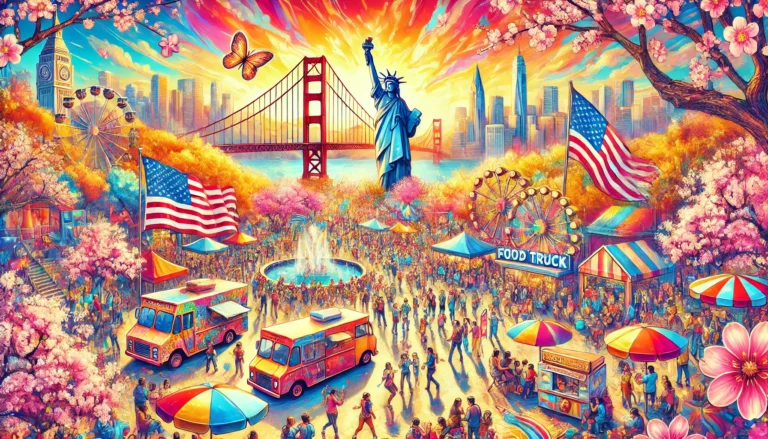A Guide to American Holidays Traditions and Celebrations
Introduction
The United States is a melting pot of cultures and traditions, which is reflected in its diverse holidays and celebrations. This guide provides an overview of major American holidays, their historical significance, and the various traditions associated with each.
A Guide to American Holidays Traditions and Celebrations
New Year’s Day (January 1)
Significance
New Year’s Day marks the beginning of the year in the Gregorian calendar. It is a time for reflection, resolutions, and celebration.
Traditions
- Midnight Celebrations: Many people celebrate with parties, fireworks, and watching the ball drop in Times Square, New York City.
- Resolutions: It is common to make New Year’s resolutions aimed at self-improvement.
- Food: Eating black-eyed peas for good luck is a Southern tradition.
Martin Luther King Jr. Day (Third Monday in January)
Significance
This holiday honors the civil rights leader Martin Luther King Jr., celebrating his contributions to civil rights and social justice.
Traditions
- Community Service: Many people participate in service projects to honor King’s legacy.
- Educational Programs: Schools and organizations hold discussions and events focused on King’s impact.
Valentine’s Day (February 14)
Significance
Valentine’s Day celebrates love and affection between intimate partners.
Traditions
- Gifts: Exchanging gifts such as chocolates, flowers (especially roses), and cards.
- Romantic Dinners: Many couples go out for a special dinner or prepare a romantic meal at home.
Easter (Date Varies)
Significance
Easter commemorates the resurrection of Jesus Christ and is a significant holiday in Christianity.
Traditions
- Easter Eggs: Families often participate in egg decorating and egg hunts for children.
- Church Services: Many Christians attend church services on Easter Sunday.
- Feasting: Traditional meals may include ham or lamb.
Independence Day (July 4)
Significance
Independence Day celebrates the adoption of the Declaration of Independence in 1776, marking the birth of the United States.
Traditions
- Fireworks: Fireworks displays are common in cities and towns across the country.
- Barbecues: Many Americans celebrate with picnics and barbecues featuring hot dogs and hamburgers.
- Parades: Parades featuring music, floats, and patriotic displays are held in many communities.
Halloween (October 31)
Significance
Halloween has origins in ancient Celtic festivals, particularly Samhain, and is now celebrated primarily as a fun holiday for children and adults alike.
Traditions
- Trick-or-Treating: Children dress in costumes and go door-to-door asking for candy.
- Costume Parties: Both children and adults enjoy dressing up for themed parties.
- Decorations: Homes are often decorated with spooky themes, including jack-o’-lanterns.
Thanksgiving (Fourth Thursday in November)
Significance
Thanksgiving is a day to give thanks for the harvest and blessings of the past year. It has historical roots in a 1621 harvest feast shared between Pilgrims and Native Americans.
Traditions
- Thanksgiving Dinner: A traditional meal includes turkey, stuffing, cranberry sauce, and pumpkin pie.
- Family Gatherings: Families often come together to celebrate and express gratitude.
- Parades and Football: Many cities host Thanksgiving Day parades, and football games are a staple of the holiday.
Christmas (December 25)
Significance
Christmas celebrates the birth of Jesus Christ and is widely observed as a cultural holiday in the U.S.
Traditions
- Decorating: Homes are decorated with Christmas trees, lights, and ornaments.
- Gift Giving: Exchanging gifts with family and friends is a central tradition.
- Religious Observances: Many attend church services on Christmas Eve or Christmas Day.
New Year’s Eve (December 31)
Significance
New Year’s Eve marks the end of the year and is celebrated with festivities leading up to midnight.
Traditions
- Parties and Gatherings: Many host or attend parties to ring in the New Year.
- Countdown: People often gather to count down the last seconds of the year, culminating in a toast at midnight.
- Fireworks: Celebrations typically include fireworks displays in cities.
Conclusion
American holidays are rich in tradition and offer a glimpse into the country’s diverse cultural landscape. From reflective observances to joyful celebrations, these holidays provide opportunities for connection, gratitude, and celebration of shared values.
By understanding these holidays and their significance, you can appreciate the vibrant tapestry of American life and perhaps even join in the festivities.
This guide serves as an overview of American holidays and their traditions, making it a valuable resource for anyone looking to understand or participate in these celebrations.



